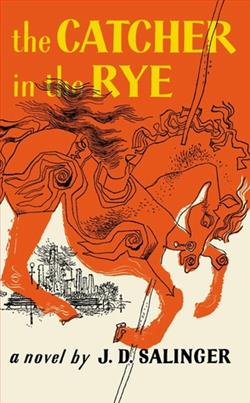Summary

Catcher in the Rye
by J.D. Salinger
It's Christmas time and Holden Caulfield has just been expelled from yet another school...
Fleeing the crooks at Pencey Prep, he pinballs around New York City seeking solace in fleeting encounters—shooting the bull with strangers in dive hotels, wandering alone round Central Park, getting beaten up by pimps and cut down by erstwhile girlfriends. The city is beautiful and terrible, in all its neon loneliness and seedy glamour, its mingled sense of possibility and emptiness. Holden passes through it like a ghost, thinking always of his kid sister Phoebe, the only person who really understands him, and his determination to escape the phonies and find a life of true meaning.
.
Read
Catcher in the Rye on http://kissnovel.net
Martial Peak Reviews
J.D. Salinger's The Catcher in the Rye is a seminal piece of American literature that continues to resonate with readers decades after its initial publication in 1951. The novel's protagonist, Holden Caulfield, has become an enduring symbol of teenage angst and rebellion, capturing the complexities of adolescence with a raw authenticity that few other works have achieved. Salinger's novel is a profound exploration of identity, alienation, and the search for meaning in a world that often feels overwhelmingly superficial.
The story unfolds during the Christmas season, a time traditionally associated with warmth and family, yet for Holden, it becomes a period of profound isolation and introspection. Having been expelled from Pencey Prep, a prestigious boarding school, Holden embarks on a journey through New York City. This journey is not just a physical one but also a deeply psychological exploration of his inner turmoil. The city, with its dazzling lights and bustling streets, serves as both a backdrop and a character in its own right, reflecting Holden's internal conflict between the allure of connection and the comfort of solitude.
One of the most striking aspects of The Catcher in the Rye is Salinger's masterful use of first-person narration. Holden's voice is distinctive, characterized by its conversational tone, candidness, and frequent digressions. This narrative style allows readers to intimately experience Holden's thoughts and emotions, creating a sense of immediacy and authenticity. Through Holden's eyes, we see a world filled with "phonies"—people who are insincere, superficial, and hypocritical. His disdain for these individuals is palpable, yet it also reveals his deep-seated desire for genuine human connection and understanding.
Holden's relationship with his younger sister, Phoebe, is one of the novel's most poignant elements. Phoebe represents innocence and purity, qualities that Holden desperately seeks to preserve in a world he perceives as corrupt. His interactions with her are tender and sincere, offering a glimpse into the vulnerability that lies beneath his cynical exterior. Phoebe's unwavering belief in Holden provides him with a sense of grounding and purpose, highlighting the novel's central theme of the struggle to protect innocence in a world that seems intent on destroying it.
The novel's title, The Catcher in the Rye, is derived from Holden's misinterpretation of a Robert Burns poem. Holden envisions himself as the "catcher" who stands in a field of rye, saving children from falling off a cliff—a metaphor for losing their innocence. This fantasy underscores Holden's desire to shield others from the harsh realities of adulthood, even as he grapples with his own transition into that very world. It is a poignant reflection of his internal conflict and his longing for a simpler, more authentic existence.
Salinger's exploration of themes such as alienation, identity, and the loss of innocence is both timeless and universal. Holden's experiences resonate with readers of all ages, as they capture the quintessential struggle of finding one's place in a world that often feels alienating and disingenuous. The novel's enduring appeal lies in its ability to articulate the complexities of adolescence with honesty and empathy, offering readers a mirror through which to examine their own experiences and emotions.
In comparison to other coming-of-age stories, such as Harper Lee's To Kill a Mockingbird or John Knowles' A Separate Peace, The Catcher in the Rye stands out for its unflinching portrayal of teenage disillusionment. While Lee's novel explores themes of racial injustice and moral growth through the eyes of a young girl, and Knowles' work delves into the complexities of friendship and rivalry, Salinger's novel is singular in its focus on the internal struggles of its protagonist. Holden's journey is not one of external conflict but of internal reckoning, making it a deeply personal and introspective narrative.
The impact of The Catcher in the Rye extends beyond its literary merits. It has become a cultural touchstone, influencing countless works of literature, film, and music. Its themes of rebellion and nonconformity have resonated with generations of readers, cementing its status as a classic of modern literature. The novel's exploration of the human condition, with all its complexities and contradictions, continues to captivate and challenge readers, inviting them to reflect on their own experiences and beliefs.
In conclusion, J.D. Salinger's The Catcher in the Rye is a masterful exploration of the adolescent experience, capturing the essence of teenage angst and the search for authenticity in a world that often feels overwhelmingly superficial. Through Holden Caulfield's journey, Salinger offers a poignant reflection on the struggle to preserve innocence and find meaning in a world that seems intent on eroding both. The novel's enduring appeal lies in its ability to resonate with readers of all ages, offering a timeless exploration of the human condition that continues to inspire and provoke thought.








![(C94) [Sokuseki Maou (Bonkara)] Horror Night Nishizumi (Girls und Panzer)](/upload/pic/manga/c94--sokuseki-maou-bonkara--horror-night-nishizumi-girls-und-panzer.jpg)















Reviews 0
Post a Reviews: